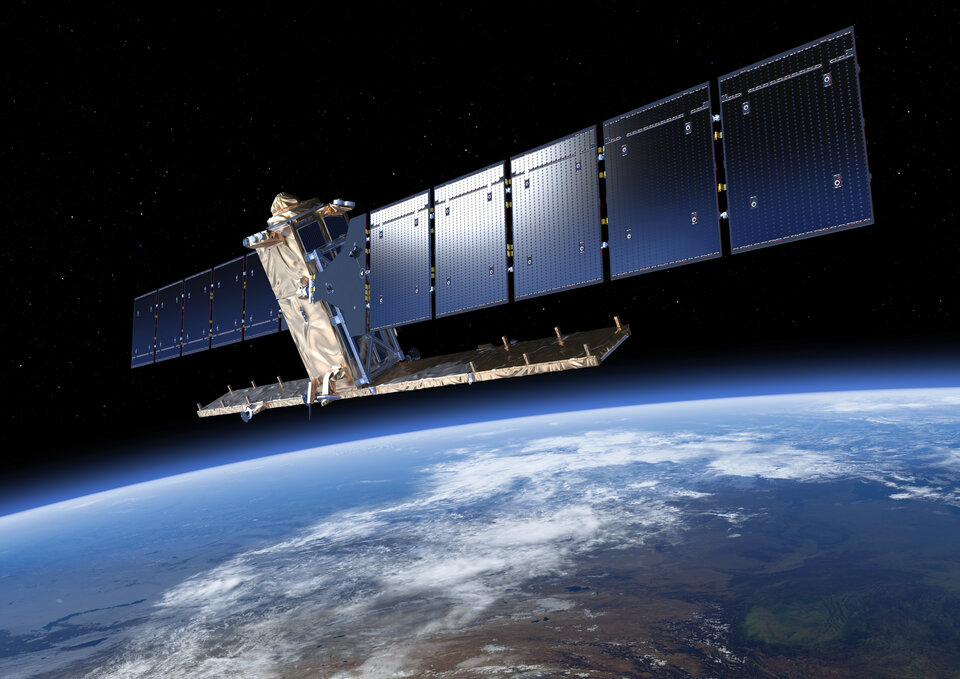Sentinel-1B launched to complete radar pair
The second Sentinel-1 satellite – Sentinel-1B – was launched today to provide more ‘radar vision’ for Europe’s environmental Copernicus programme.
Sentinel-1B lifted off on a Soyuz rocket from Europe’s Spaceport in Kourou, French Guiana, at 21:02 GMT (23:02 CEST), separating from the rocket’s Fregat upper stage 23 min 35 sec later.
Sentinel-1B joins its identical twin, Sentinel-1A, in orbit to deliver information for numerous services, from monitoring ice in polar seas to tracking land subsidence, and for responding to disasters such as floods.

“The launch of Sentinel-1B marks another important milestone as this is the first constellation we have realised for Copernicus,” said ESA’s Director General Jan Woerner.
“Orbiting 180° apart, the two satellites optimise coverage and data delivery for services that are making a step change in the way our environment is managed.”
Both satellites carry an advanced radar that images Earth’s surface through cloud and rain regardless of whether it is day or night.

During the launch, the satellite’s 12 m-long radar antenna and two 10 m-long solar wings were folded up to fit into the Soyuz rocket’s protective fairing.
The solar wings and radar open together in a careful sequence that will take about 10 hours to complete.
Now that Sentinel-1B has been placed safely in orbit, the team of controllers at ESA’s operations centre in Germany will ensure that everything is working correctly and commission the satellite for operations.
Volker Liebig, ESA’s Director of Earth Observation Programmes, said, “We have seen some marvellous results from Sentinel-1A. Only two weeks ago, for example, it captured images of large icebergs breaking away from Antarctica’s Nansen ice shelf


Access the video
“Given that Antarctica is heading into winter now and daylight hours are getting shorter, radar images are vital to see what changes are taking place.
“With Sentinel-1B in orbit we will receive double the amount of data and achieve global coverage in six days.
“This is the fourth satellite that we’ve launched for Copernicus in just two years and this launch is certainly a special moment because it completes the Sentinel-1 constellation.”
The launch of Sentinel-1B also provided an opportunity to give other smaller satellites a ride into space.
Three CubeSats took advantage of today’s launch. These small satellites, each measuring just 10×10×11 cm, were developed by teams of university students through the ‘Fly Your Satellite!’ programme, run by ESA’s Education & Knowledge Management Office in close collaboration with European universities.

The three CubeSats are: OUFTI-1 from the University of Liege, Belgium, e-st@r-II from the Polytechnic of Turin, Italy, and AAUSat-4 from Aalborg University, Denmark.
“Importantly, the programme is helping to educate the next generation of scientists and engineers by transferring ESA knowhow in designing, building, testing, launching and operating satellites,” said Piero Galeone, ESA’s Head of the Tertiary Education Unit.
“This way we are helping to shape the space workforce of the future by enabling students to experience the full lifecycle of a real space project according to ESA’s standards.”
The other satellite that piggybacked a ride today is Microscope from the French space agency, CNES.














 Germany
Germany
 Austria
Austria
 Belgium
Belgium
 Denmark
Denmark
 Spain
Spain
 Estonia
Estonia
 Finland
Finland
 France
France
 Greece
Greece
 Hungary
Hungary
 Ireland
Ireland
 Italy
Italy
 Luxembourg
Luxembourg
 Norway
Norway
 The Netherlands
The Netherlands
 Poland
Poland
 Portugal
Portugal
 Czechia
Czechia
 Romania
Romania
 United Kingdom
United Kingdom
 Slovenia
Slovenia
 Sweden
Sweden
 Switzerland
Switzerland






































